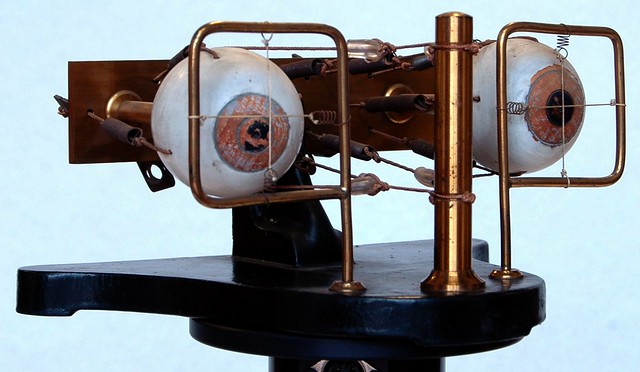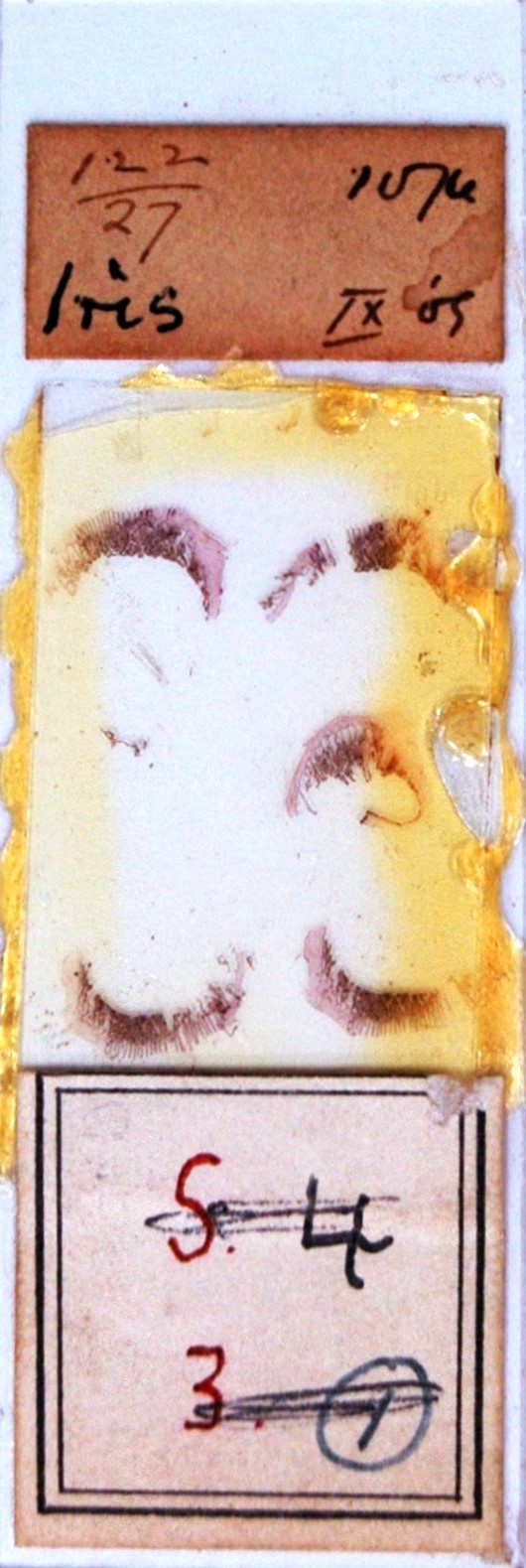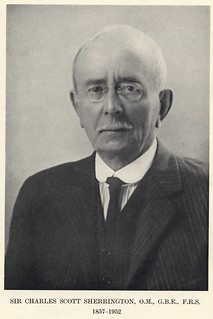 Sometime in early 1911, Charles Scott Sherrington, Holt professor of physiology at the University of Liverpool, took receipt of an unusual piece of scientific equipment. The item in question had been manufactured by the Cambridge Scientific Instrument Company (founded by Charles Darwin’s youngest son Horace in 1881). Unlike much of the output of that company however, this item was not intended for use in research. Rather, it was designed for the demonstration of a physiological ‘law’ at scientific lectures and conferences. The law in question (‘Listing’s Law’) related to the nature of vision – a preoccupation of Sherrington’s that lasted his whole life. Above all a tool for conveying physiological science, this object tells us much regarding what Sherrington believed to constitute effective communication.
Sometime in early 1911, Charles Scott Sherrington, Holt professor of physiology at the University of Liverpool, took receipt of an unusual piece of scientific equipment. The item in question had been manufactured by the Cambridge Scientific Instrument Company (founded by Charles Darwin’s youngest son Horace in 1881). Unlike much of the output of that company however, this item was not intended for use in research. Rather, it was designed for the demonstration of a physiological ‘law’ at scientific lectures and conferences. The law in question (‘Listing’s Law’) related to the nature of vision – a preoccupation of Sherrington’s that lasted his whole life. Above all a tool for conveying physiological science, this object tells us much regarding what Sherrington believed to constitute effective communication.
As well as conducting highly respected physiological research, Sherrington was an enthusiastic communicator of his and his colleagues’ physiological findings. In addition to adopting the Listing model, he developed a means of demonstrating the subjectivity of colour perception by, as the journal Nature put it in 1897, ‘whirling a disc coloured red on a black-white ground.’ He also became an early user of film as a medium of demonstration, using it both to communicate experiments themselves, and to convince audiences that animals that he had used in these experiments had not suffered ill effects from them.
Science studies scholars such as Jonathan Crary have contended that the ways in which scientists communicate not only reflects the attitudes and beliefs of their time, but also contributes to the emergence of new ideas regarding how knowledge is best conveyed, apprehended and understood. In the case of physiology - and especially the physiology of perception - the question of communicating knowledge is intimately bound up with the research process itself. Physiologists’ understandings of the bodily processes of perception, the operation of the sensory organs, and their interaction with each other via the nervous system, have important implications as to how scientists seek to convey their findings. Sherrington’s activities regarding the physiology of vision were no exception in this regard.
Image and perception in nineteenth-century physiology
Much physiological communication in Britain during the nineteenth century had centred on the production and display of static images and objects. For many early nineteenth century investigators, the vast majority of instruction was carried out via lectures given in front of large classes of students. Carefully crafted images, often displayed in ascending series intended to illustrate the ‘progress’ of life, were accompanied by similarly laid-out progressions of preserved anatomical parts. Research centred to a great extent on museums, and many physiologists relied on such institutions for their livelihoods. In Britain, museums and lecture halls were places within which audiences would expect to be shown the wonders of living creation. And whether a physiologist conceived of this creation as a series of discrete events personally directed by a deity, or a single and ultimately indivisible developmental whole, images and objects held pride of place as indicators of the nature of life.
The early nineteenth-century reliance on static imagery and anatomical display accorded well with an understanding of perception that had gained popularity during the eighteenth century. This understanding centred on the notion that mental activity could be characterised in terms of the mind’s receipt of ‘sense-impressions’ from the outside world. Philosophers such as John Locke had argued that individuals’ minds were built up of discrete sensational units which they assimilated via the sensory organs. Rational comprehension consisted in the correct ordering of these sensations. Sequences of events or relations between objects could be represented to the mind by the presentation to it of successive images, each representing a single instance of the broader whole.
By the 1870s and 1880s however, alternative approaches to physiological education and display were beginning to take hold. Henning Schmidgen has shown how in Germany, where laboratories for physiology had found increasing institutional purchase since the 1830s, emphasis was put on the production of dynamic visual effects as well as on the display of static images and objects. Physiology in this context came to be understood as a body of knowledge that could be most effectively conveyed via Anschauungsunterricht, or intuitive visual instruction. Drawing on a long tradition of demonstrative performance that had been practised in anatomical theatres since the sixteenth century, German physiologists deployed an impressive range of tools and devices designed to inform audiences of the nature of muscular activity or nervous sensitivity. Above all, these devices sought to convince through movement – the moving parts of a carefully prepared frog, a set of metal rods attached to the beating heart to demonstrate its activity, or a set of zoetrope-produced moving images were all employed to convince students of the reactivity of muscle, responsiveness of cardiac action, or the sensitivity of nerves.
There was little in the theatrical culture of German physiology to contradict Locke and others’ conception of mind as built up of sense-impressions. Yet German physiologists tended to emphasise a rather different philosophical tradition, more indebted to the German natural philosopher Gottfried Wilhelm von Leibniz than any writer in the English tradition. These physiologists emphasised the capacity of imagery and demonstrative performance to stimulate individuals’ ‘intuitions’, as well as their rational, conscious minds. Employing an array of tools and experimental set-ups, they aimed to create visual effects that would induce intellectual comprehension in their students without recourse to the purely intellectual medium of language. Imagery and performance were understood as capable of conveying physiological truths that writing and lecturing could not.
The emergence of a distinct emphasis on experimental demonstration in Germany did have a counterpart in Britain. This however owed rather more to the pragmatic concern of ensuring continued national success than it did to adherence to one or another philosophic tradition. During the 1860s and 1870s, a wide range of British experimental practitioners put forward arguments intended to guarantee the institution of laboratories in British higher education along the German model. Central to their efforts was the claim that if Britain was to continue to compete with the increasing industrial might of the young German state, then they must also adopt its educational practices. These (it was understood) were particularly effective in training strong, efficient industrial citizens. Their efforts met with some success. By the late 1870s, textbooks such as William Benjamin Carpenter’s popular Principles of Human Physiology (9 eds, 1842-1881), largely taken up with written descriptions of the conclusions of physiological research, had begun to be replaced by step-by-step guides to the conduct of experiment such as John Burdon-Sanderson’s controversial Handbook for the Physiological Laboratory (1873). The new laboratories established in Britain’s educational institutions during the 1870s and 1880s were understood by many as sites of industrial training, where the hand and eye would be taught to act in accordance with the inventive capacities of the mind.
An eye for experiment: Sherrington's physiology of vision
By 1880, when Sherrington began his training at Cambridge, physiological laboratories had been established in many of Britain’s leading educational institutions. This meant that he became one of the first students in Britain to experience a thoroughly experimental education in physiology. As a student at the university, he was amongst the earliest beneficiaries of the laboratory-centred approach to physiological training conducted under Michael Foster. Around the same time, he came into contact with Friedrich Goltz, professor of physiology at Strasburg. By 1884, he was collaborating with Ernst Ewald, Goltz’s assistant at the university, and would over the next three years go on to work with such German physiological luminaries as Rudolph Virchow and Robert Koch, both of whom based in Berlin.
Whether a consequence of his experimental training in Cambridge, or the result of his close engagement with the German physiological tradition, Sherrington’s investigations in the physiology of perception placed great emphasis on the activity of parts of the body not generally associated with the operation of the conscious mind. His publications on the physiology of vision, for example, are almost entirely taken up with examinations of the possibility that the nerves connected to eye muscles actively contribute to the construction of mental imagery. Following a line of research that had been initiated by Hermann von Helmholtz’s assistant Wilhelm Wundt during the 1860s, Sherrington argued that individuals’ perception of space was at least in part dependent on nerves whose function it was to sense the movement of the eye muscles. As he put it in a paper published in Brain in 1918, based on over twenty years of research into nerves that connect to the muscles of the eye:
The orientation of the retina in space in regard to the line of gravity, that is to say in the mind in regard to verticality, results from co-operation between the spatial gravity sense-organ and the muscular sense of the orbital muscles... [the posture of the eyeball] is perceived by the mind not as a state of the eyeball, but as a state of the external world, of the world as seen; it is “projected.” (341-342)
Referring to the ‘co-operation’ of visual and muscular senses with a third gravity-sensing organ, the ‘otic labyrinth’, Sherrington argued that ‘spatial perceptions… are not purely visual, but are in fact… visuo-musculo-labyrithine’ (343). The eyes were not isolated conveyors of images, to be associated by the mind in turn with smells, tastes, sounds and so on. Rather, they were organs that depended on the rest of the body for their operation, and which combined with those other parts in conveying a sense of external reality.
The above-mentioned apparatus concerned with the demonstration of ‘Listing’s Law’ was especially relevant to these investigations. The law itself refers to the orientation of the eyeballs when positioned outside of the horizontal or vertical planes (eg. up and to the right, or down and to the left). When positioned in a purely horizontal or purely vertical manner, the eyeballs remain in their usual position in relation to the rest of the body. When moved in a diagonal plane, however, they tilt at an angle, somewhat in the direction in which they are facing (see a more detailed description here). First observed by the Dutch ophthalmologist Franciscus Donders, by exposing his retina to a cross of red light and then studying the movement of its after-image, Johann Listing had identified that these angles were subject to strict mathematical laws – a contention picked up on by Helmholtz and related at length in his Handbuch der Physiologischen Optik (1856-67). Above all, these experiments were understood as casting doubt on the capacity of the eye to convey ‘pure’ sensory data to the brain via the nervous system. Some form of interpretation or ‘intuition’ was necessary to rectify the tilted image that would otherwise be perceived.
Sherrington’s Cambridge Instrument Company demonstration apparatus was then part of a broader project, in which he emphasised that sensory organs could not be understood as simple conveyors of sense-impressions from the outside world, but were rather components of a body-wide set of organs that together enabled perception to take place. The operation of these organs depended on the interaction (or as Sherrington would put it, the ‘integration’) of its various parts. Visual impressions were conveyed not by the eyes alone, but by the combination and coordination afforded by all of the nerves relating to an individual’s orientation in space. The position of the eyes in relation to the rest of the body, the extent to which they were not aligned with it in their usual manner, and the more general sense of up and down afforded by the otic labyrinth were all integrated by the action of the nervous system. It was the combined stimulation of different nerves, rather than any direct conveyance of light hitting the retina, that produced our sense of external visual reality.
Given his immersion in both questions relating to the physiology of perception, and the emerging laboratory cultures of both England and Germany, it is perhaps unsurprising that Sherrington became such an enthusiastic adopter and developer of demonstration apparatus. Other physiologists of this time were similarly committed to the production of moving images and mechanical demonstrations of their conclusions. But Sherrington appears to be unique, at least amongst British physiologists of this time, in his particular emphasis on the active participation of the organs of movement in the production of sensation. His commitment to understanding the significance of the operation of muscles in the perceptive process – evinced by the histological specimens relating to ocular physiology that still survive from his time at Oxford – gave him a heightened awareness of the effectiveness of those communication techniques that had emerged amongst German physiologists during the 1860s and 1870s. Moving images and objects encouraged the eye to move, and thereby involved the visual sense as he conceived it to a far greater extent than any static picture or specimen ever could.
- No links match your filters. Clear Filters
-
Cites
 The International Congress of Physiologists, British Medical Journal, 20 September 1913 (2), pp. 750-752.
The International Congress of Physiologists, British Medical Journal, 20 September 1913 (2), pp. 750-752.
Description:‘A good deal of use was made of the cinematograph for purposes of demonstration. It was used to illustrate two communications made by Dr. T. Graham Brown, on behalf Professor Sherrington and himself. The one dealt with recent observations of rhythmic movements in the mammal, in continuation of the remarkable researches in which Professor Sherrington has been for some years engaged. He had given a demonstration of some of his results on the previous day. Dr. Graham Brown's communication afforded a connected account of the research, which was made much more easy of comprehension by the cinematograph film. A most effective example of the value of the method for demonstration was afforded by a second film, showing recovery after lesions of the motor cortex. The cortical arm area had been destroyed in an anthropoid ape, first on one side and then on the other; the recovery of function in the forelimb was shown in a most convincing manner in the film, the animal being seen to take bits of apple with one hand and pass them into the other until the supply was exhausted, when it turned round and began to put the pieces of apple into its mouth; it was also seen to hold a cup of water and drink from it, and to use its upper limbs for various purposes in a most natural manner, the whole set of movements being so easily and accurately performed that it would never have been suspected that the animal had undergone any operation.’ (751)
-
Quotes
 C.S. Sherrington, 'Observations on the sensual role of the proprioceptive nerve-supply of the extrinsic ocular muscles', Brain, 41 (3-4), 1918, pp. 332-343.
C.S. Sherrington, 'Observations on the sensual role of the proprioceptive nerve-supply of the extrinsic ocular muscles', Brain, 41 (3-4), 1918, pp. 332-343.
Description:'The orientation of the retina in space in regard to the line of gravity, that is to say in the mind in regard to verticality, results from co-operation between the spatial gravity sense-organ and the muscular sense of the orbital muscles... [the posture of the eyeball] is perceived by the mind not as a state of the eyeball, but as a state of the external world, of the world as seen; it is “projected.”' (341-342)








